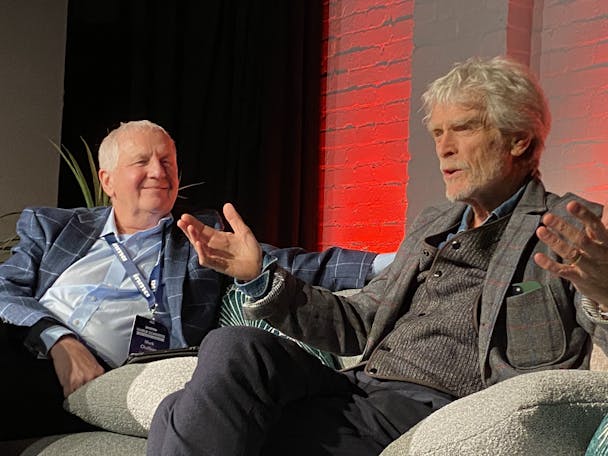‘The end of the world isn’t nigh, it’s AI’ according to Sir John Hegarty
The acclaimed adman is not afraid of AI, but insists creativity remains brands’ biggest strategic asset.

INMA’s Mark Challinor and Sir John Hegarty in conversation at The Drum Labs
“The end of the world isn’t nigh, it’s AI,” Sir John Hegarty told a meeting of the International News Media Association, which was hosted at The Drum Labs.
The BBH and Garage Soho founder was in conversation with INMA executive producer Mark Challinor. However, he stressed beneath his quip there is a serious point: “The transformative potential of AI is akin to the internet or television – it can change everything, but only if we understand how to creatively engage with it.”
That message underlined the key theme of the conversation: Hegarty’s defining belief that in the race for market dominance, true distinction lies in creativity.
“Creativity is not just a department within a company; it is the engine of brand value,” Hegarty said. He reminisced about the golden age of advertising in New York during the 60s, citing legends like Bill Bernbach. “It was smart, intelligent, aesthetic, but also inclusive and funny. That’s a lesson for what’s going to go forward. We need to engage and inspire, not just promote.”
Hegarty criticized today’s over-reliance on algorithms, which, according to him, prioritize promotion over persuasion. “We’ve become obsessed with the mechanics of delivery rather than the art of engagement. You’ve got to persuade and promote. You can’t just do one without the other,” he argued, emphasizing the necessity of building a belief around a brand.
- Sir John Hegarty: marketers are overusing dance in their commercials
In an anecdote about branding, Hegarty highlighted the intrinsic value of a company’s image through a simple yet effective example involving Coca-Cola and Pepsi. “I always regret not demonstrating it more vividly. I should have placed a can of Coke and a can of Pepsi on the table during a pitch and asked, ‘Which one would you rather invest in?’ Without fail, they’d pick Coke despite both products tasting virtually the same. It’s not about the product; it’s about the brand.”
The dialogue then shifted to the strategic use of media in today’s fragmented landscape. “There’s only one space that matters,” Hegarty declared, “and that’s the space between somebody’s ears. That’s where you want your message to reside. Everything else is irrelevant.” He described this space – the corner of someone’s mind – as the most valuable piece of real estate in the world.
Reflecting on the role of brands in today’s culture, Hegarty lamented their diminished impact compared with past decades. “Brands are no longer a part of culture as they once were. Communication isn’t a part of culture the way it was 25, 30 years ago, which helped make a brand more important and created value for it.”
The discussion wrapped up with audience questions, one of which touched on the topic of challenger brands like Pepsi. “Challenger brands need to do exactly what their name suggests: challenge,” Hegarty responded. “They need to carve out a niche, a unique space that differentiates them distinctly from the leaders.”
As the session closed, Hegarty’s call to embrace creativity as a critical strategic asset was clear. He urged the audience to think beyond conventional strategies, to innovate continuously and to embed creativity deeply within their corporate ethos. “We are all creative,” he noted. “Just some of us don’t know what we’re looking for. But getting people to understand that is crucial.”
In an era dominated by digital transformations and technological advancements, Sir John Hegarty’s message resonates more profoundly than ever: harness creativity to build brands that are not only profitable but also beloved and enduring. His final words, a blend of challenge and encouragement, left the audience inspired, “It’s not just about making noise; it’s about making music that people remember.”

